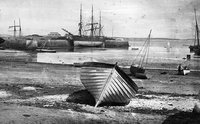Perhaps the most tragic shipwreck ever to occur in the waters around the Islands was that of the Schiller in 1875 which signalled the death of 335 men women and children. The Schiller was a German Ferry, one of the largest ocean going ships of her day, she had set off from New York on 27 April, bound for Plymouth and then Hamburg. She carried a cargo of valuable goods such as gold coins and sewing machines as well as 254 passengers and 118 crew, who were mainly German.
- Job: Passenger transport, mail steamer
- Shipping Company: Eagle Line. Ship owned by German Transatlantic Steam Navigation Company.
- Launched: Glasgow, 1873.
- Tonnage: 3,420 tons
Incident
- Difficulty: Ran aground, wrecked
- Date: 7 May 1875
- Shipping route: New York via Plymouth to Hamburg
- Passengers & cargo: 118 crew, 254 passengers, 312 lives lost. 250 sacks of mail, 197 lost.
- Location: Retarrier Ledges
She was making exceptional time for her transatlantic journey, despite encountering fog on 4 May. A thick fog descended on the evening of 7 May, when the Schiller was expecting to arrive in Scilly. A passenger noted that it was not possible to see ‘from stem to stern.’ Captain Thomas decrease her speed to about 4 knots. Lookouts were posted to try and spot Bishop Rock Lighthouse or hear its fog bell. The lighthouse was never seen and they had fatefully sailed inside the Bishop.
At 22.00, she experienced a jolt. She had steamed onto Retarrier Ledge at 4 knots and after she had reversed off again, a series of freak waves swept her broadside to the ledge, inflicting substantial damage.
Panic broke out along the length of the boat. The Captain ordered the seven lifeboats be launched. The attempts at escape were futile and chaotic. Lifeboats were cut loose and crushed due to poor maintenance and two full lifeboats were crushed, killing many passengers, when the funnel fell onto them. There have since been accusations of extraordinary cowardice, men pushing aside women and children in an attempt to reach the boats. This lead to many of the women and children having to hide under the main cabin, they were later drowned when a wave tore off the roof and swept the bodies out to sea.
The Captain fired shots from his pistol in a failed attempt to restore order, cannons were let off but St Agnes and St Mary’s lifeboat crews mistook this distress signal for a customary signal to shore that all ships used of the day. As the Schiller sank further, survivors climbed the rigging; many maimed and killed by flailing chains. One man sheltered behind a body, the bodies brain had been dashed by chains. There was terror of horrific proportions, blood and death would have been thick in the air, children still clinging, petrified to their parents.
Those in lifeboats were at risk of sinking, one lifeboat found without a plug, and feared approaching other lifeboats in case they requested a transfer of passengers, increasing the risk of sinking. The two lifeboats that did manage to get away from the ship eventually ended up on Tresco, out of the 27 on board, only one was female and there were no children; they all had perished.
The St Agnes gig the O and M went out at daybreak 04.00 to investigate a report of the sound of a cannons more than one time. The crew were taken completely by surprise when they found a mast still visible above the Retarrier Ledges. It was clear that assistance would be needed so the O and M picked up five loose survivors and rowed back to St Mary’s to ask for assistance. Many steamers and ferries from St Mary’s as well as two Newlyn fishing boat raced to the scene to try and save lives. The survivors were few and far between, the sea was littered with debris and lifeless bodies, but some had managed to cling to wreckage or crawl ashore onto some of the uninhabited islands. Bodies were also recovered for a burial with dignity.
The bodies were identified and then buried with all the dignity possible; Islanders were commended on their generosity and sensitivity. The number of bodies to be buried were so great that local ponies acted as hearses to carry 37 to one funeral.
One German was insistent on finding the bodies of his two sisters who had been on the Schiller, he had hired out diving equipment and expertise from Penzance, he reportedly found one of his sisters in the clutches of a giant cuttlefish with 12-foot long tentacles. He died of shock 3 days later.
German authorities were so impressed with the way that Scillonians handled the tragedy, orders were sent during the two subsequent world wars, that Scilly and Scillonians should be spared from being bombed or attacked, in recognition of the kindness shown to their countrymen by Islanders, so may years before. The Captain had ordered the guns be fired as a distress signal, one of which was heard at midnight on shore, but mistaken as denoting a ship passing the Islands, as was the custom of North German steamships at the time. The custom had lead to several mistaken lifeboat launches. Later, Mr Smith of Tresco Abbey wrote in The Times “I have no hesitation in saying that some of the drowned in the late disastrous shipwreck […] were victims of the practice of signalling by guns.”
References
- “Wreck Of An Atlantic Steamer”. (10 May 1875). The Guardian, p. 8.
- “The Wreck Of The Schiller”. (11 May 1875). The Guardian, p. 5.
- “It is a painful conclusion…” (30 June 1875). The Guardian, p. 5.


